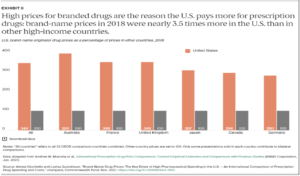Rising prescription drug prices have been a concern in the United States for many decades; a report by the RAND corporation quantifies that U.S drug prices are 2.56 times higher than other developed countries labeled by the OECD, concluding that the US spends more on drugs per capita than other countries [1].

If you are looking for a more in-depth discussion of the causes of high prescription drug prices and possible policies to mitigate these issues, we will be posting a review of it soon. But, as discussed in our earlier post, Racial Justice and Healthcare Outcomes: An Overview, it can be important to examine these disparities through a lens of racial equity as well. According to the National Academy for State Health Policy, “not only are people of color more likely to suffer from chronic illness, they are more likely to be uninsured and are therefore disproportionately hit hardest by [rising prescription drug prices]” [2].
Gender also plays a significant role in prescription drug pricing — indeed, according to the Center for American Progress, women often have higher healthcare costs than men, due to higher healthcare use rates and their roles as primary caregivers for others — women spend nearly twice as much as men aged 19-34 on healthcare [3]. According ot the same report, women, due to high prescription drug prices, are more likely to put off healthcare and skip their medications. Furthermore, pharmaceutical companies often have significantly higher prices for drugs disproportionately used by women.
Theres no doubt whatsoever that high prescription drug prices affect people from a variety of classes, genders, and races — however, to make policy more effective, its important to examine certain issues from lenses of inequity. This allows policy to remediate these systematic inequities by specifically targeting them, rather than solving a blanket issue and assuming that its disproportionate effects will also be solved!
[1]Alexander, G. Caleb; Ballreigh, Jeromie; Socal, Mariana P.; Karmakar, Taruja; Trujillo, Antonio; Greene, Jeremy; Sharfstein, Joshua; Anderson, Gerard (2017). “Reducing branded prescription drug prices: A Review of Policy Options”. Pharmacotherapy: The Journal of Human Pharmacology and Drug Therapy, EBSCO, doi: 10.1002/phar.2013.


